 Research Article
Research Article
Comparison of Physical Properties of Purl- and Rib Structures Produced in a Hand-Driven V-Bed Rib Knitting Machine
Tahmina Akhter1, Mst. Romana Akter1 , Jasnova Afroj Aurna2, Mst. Jinia Rahman2 and Iftay Khairul Alam3*
1Senior Lecturer, Department of Textile Engineering, European University of Bangladesh, Bangladesh
2Lecturer, Department of Textile Engineering, European University of Bangladesh, Bangladesh
3Assistant Professor, Department of Textile Engineering, European University of Bangladesh, Bangladesh
Iftay Khairul Alam, Assistant Professor, Department of Textile Engineering, European University of Bangladesh, Bangladesh.
Received Date:April 27, 2023; Published Date:May 10, 2023
Abstract
The article discusses the production of a unique type of fabric known as purl, which can be created using a specific type of machine featuring the double-ended latch needle. Though electronic V-Bed rib machines possess the ability to produce purl fabric, such designs are scarce. The study endeavors to produce purl fabric on a V-Bed rib machine using the manual loop transfer technique. In comparison to rib structures of similar classifications (before wash & after wash), the physical characteristics of purl structures demonstrated intriguing outcomes concerning GSM, pilling, shrinkage, and relaxation.
Keywords:Purl fabric; V-Bed rib machine; Manual loop transfer technique; Rib structures; Physical characteristics
Introduction
The properties of knitted fabrics are determined by two primary parameters, the length- and shape of the loop. The shape of the loop can be finalized during the relaxation treatment and the loop length is determined during the formation process [1]. Hence, it is crucial to control the stitch length uniformly to produce highquality fabrics. Knitted fabrics are produced with low twist yarn and have a slack construction, resulting in low abrasion resistance and pilling performance [2].
To make knit fabrics more comfortable, manufacturers are experimenting with changes in fibers, yarn parameters, and knitting parameters [3]. Shrinkage is a significant problem in knitted fabrics and for garment manufacturers and achieving low residual shrinkage is a challenge [4].
The aim is to investigate the feasibility of producing purl structures on a hand-driven V-Bed knitting machine, as well as to evaluate and compare the physical properties of purl structures with those of rib structures. Furthermore, the study seeks to compare the physical properties of various purl structures to examine potential variations in these properties within the purl structure category.
Materials & Methods
Materials
3.3 Ne and 4.1 Ne acrylic yarns have been used for the production of 4 different purl structures. A single feeder, 3.5 gauge V-bed rib knitting machine (36” needle bed length) has been involved here. The machine is equipped with 75 needles in each bed.
Loop transfer element, dead weight, needle selector, comb and comb wire have been used during the production of the fabrics. Martindale pilling & abrasion tester (M235), Whirlpool top loading washing machine (3XGSC9455), GSM cutter and shrinkage/ relaxation measuring scale have also been used for the testing purposes.
Methods
The process of producing purl fabric involves several steps. Initially, the machine settings are checked to ensure that the machine is functioning correctly.
To produce 1x1 purl, the front bed is activated first while the back bed is deactivated with the help of the cam selector. A comb and comb wire have been used to hold all the loops of the first course. A dead weight is hung for applying appropriate tension to the comb. The first course is produced in this manner.
Once the first course is produced, the front bed is deactivated, and the back bed is activated. Using a loop transfer element, the loops are transferred from the front bed to the back bed. The carriage is moved from one end to the other end of the bed to produce the second course. This procedure has been repeated until all the courses are produced, and hence, 1x1 purl fabric is achieved (Figures 1 & 2).


In the case of 2x2 purl fabric, a similar procedure has been followed for producing the first course. The carriage has been moved twice across the bed while transferring the loops from the front bed to the back bed and vice-versa. The front bed has been activated while the back bed is deactivated, and the loops are transferred from the back bed to the front bed. This process is repeated until all the courses have been produced, and hence, 2x2 purl fabric is achieved.
Similarly, for producing 3x3 and 4x4 purl fabric, the same procedure has been followed. However, the carriage is driven three times for 3x3 purl fabric and four times for 4x4 purl fabric. By this procedure, purl fabric can be successfully produced in the V-Bed rib knitting machine (Figure 3-6).




Results & Discussion
Graphical representation of data
Comparison of wpcm between purl and rib structures before wash & after wash: The data presented in Figures 7 and 8 illustrate that for both 3.3 Ne and 4.1 Ne yarn counts, the WPcm of 1x1 purl structure was lower than that of 1x1 rib structure in both pre-wash and post-wash conditions. The same pattern was observed for 2x2 purl and rib, 3x3 purl and rib, as well as 4x4 purl and rib structures.
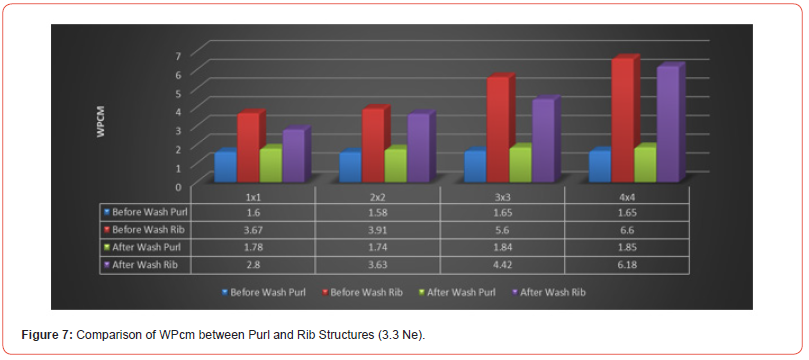
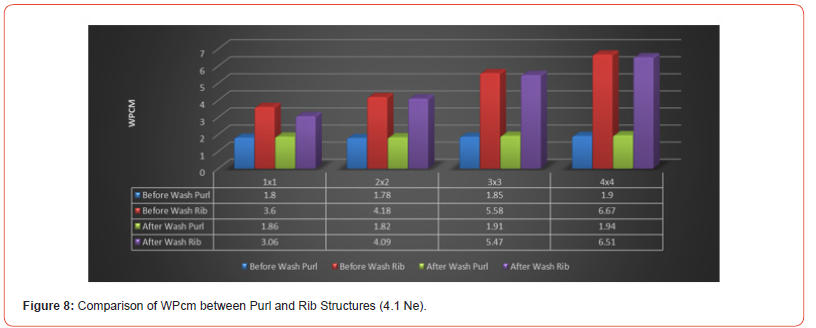
Comparison of wpcm between purl structures before wash & after wash: Figure 9 shows a clear increase in WPcm for 1x1 purl structures after washing. This trend was also observed for 2x2 purl, 3x3 purl, and 4x4 purl structures produced from both 3.3 Ne and 4.1 Ne acrylic yarn. Prior to washing, the WPcm values for 1x1 purl structures were lower than those after washing.
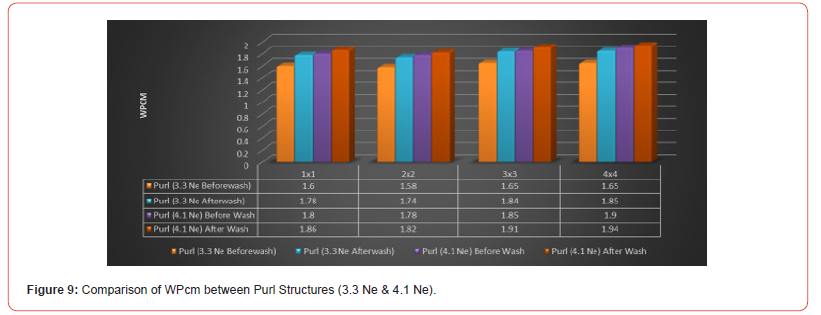
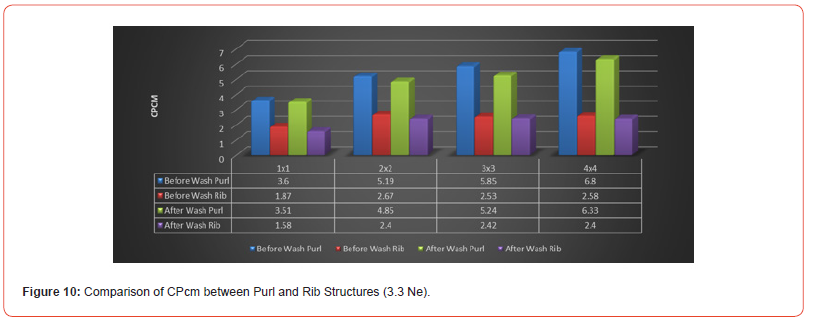
Comparison of CPcm between Purl and Rib structure before wash & after wash: The data presented in Figures 10 and 11 demonstrate that for both 3.3 Ne and 4.1 Ne yarn counts, the CPcm of 1x1 purl structure was higher than that of 1x1 rib structure in both pre-wash and post-wash conditions. This trend was also observed for 2x2 purl and rib, 3x3 purl and rib, as well as 4x4 purl and rib structures.
Comparison of CPcm between purl structures before wash and after wash: According to Figure 12, there was a clear decrease in CPcm for 1x1 purl structures after washing, for both 3.3 Ne and 4.1 Ne yarn counts. This trend was also observed for 2x2 purl, 3x3 purl, and 4x4 purl structures. Prior to washing, the CPcm values for 1x1 purl structures were higher than those after washing.
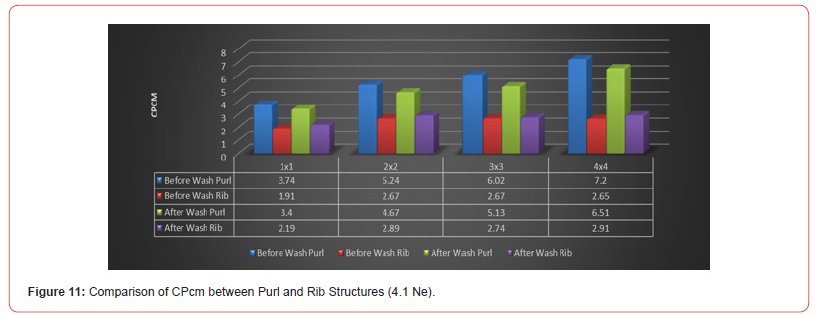
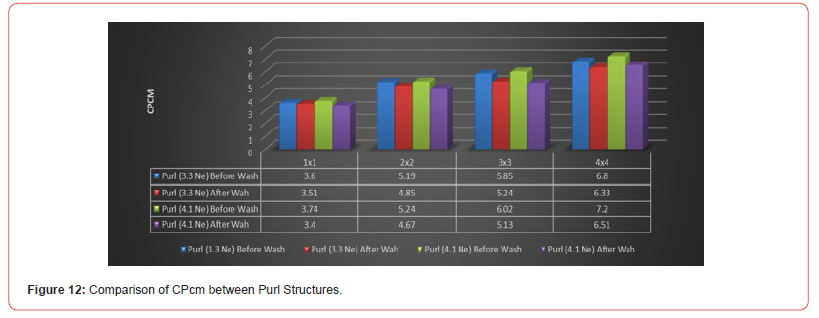
Comparison of GSM between Purl and Rib Fabric before wash & after wash: The Figures 13 and 14 indicate that for fabrics made from both 3.3 Ne and 4.1 Ne yarn counts, 1x1 rib structures exhibited a higher GSM than 1x1 purl structures in both pre-wash and post-wash conditions. This trend was also observed for 2x2 purl and rib, 3x3 purl and rib, as well as 4x4 purl and rib structures.

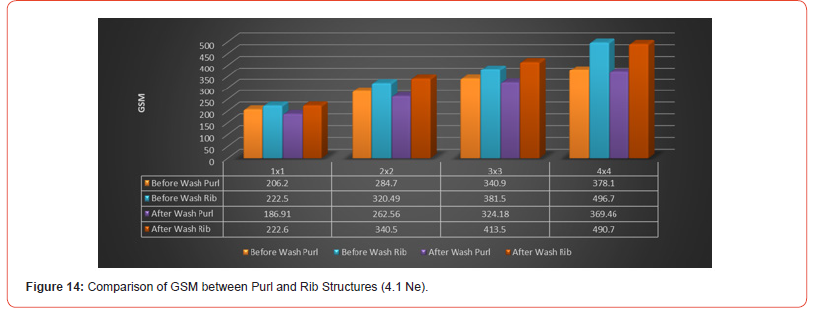
Comparison of GSM of Different Purl Structures: Figure 15 shows that prior to washing, the GSM of 1x1 purl structures, for both 3.3 Ne and 4.1 Ne yarn counts, were higher than those of postwashed 1x1 purl structures. The same trend was observed for 2x2 purl, 3x3 purl, and 4x4 purl structures.
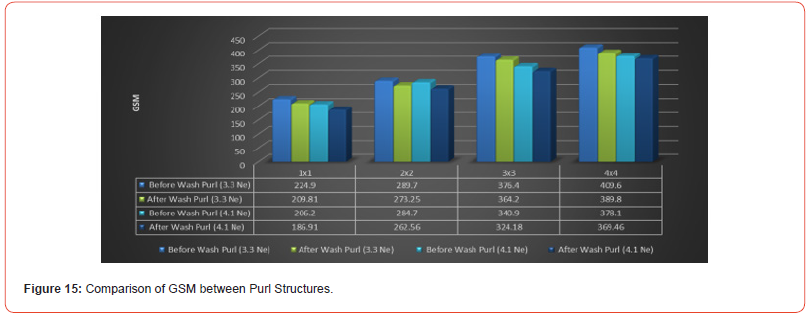
Comparison of lengthwise shrinkage or relaxation: Based on the findings presented in Figure 16, purl- and rib fabrics made from the same yarn count exhibited different behaviors after washing. Specifically, purl structures exhibited relaxation, while rib structures exhibited shrinkage. This is attributed to the greater lengthwise extensibility of purl structures.
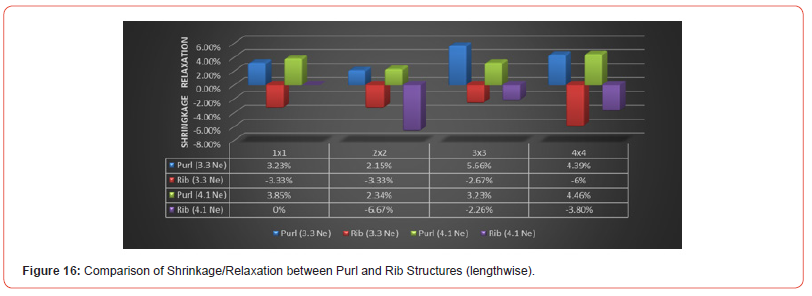
Comparison of widthwise shrinkage or relaxation: Based on the results presented in Figure 17, it is clear that after washing, fabrics made from the same yarn count showed different results. Rib derivatives exhibited relaxation, while purl derivatives exhibited shrinkage. This is attributed to the widthwise extensibility of rib structures.
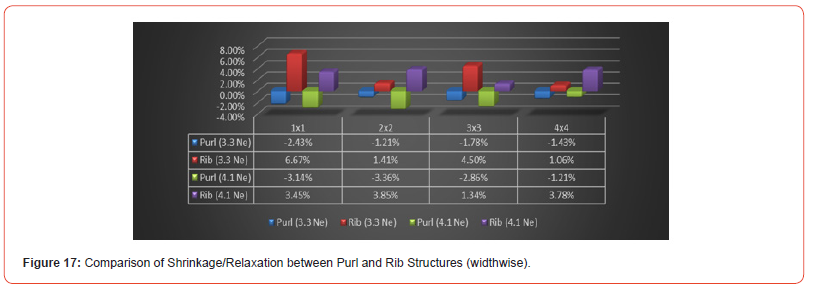
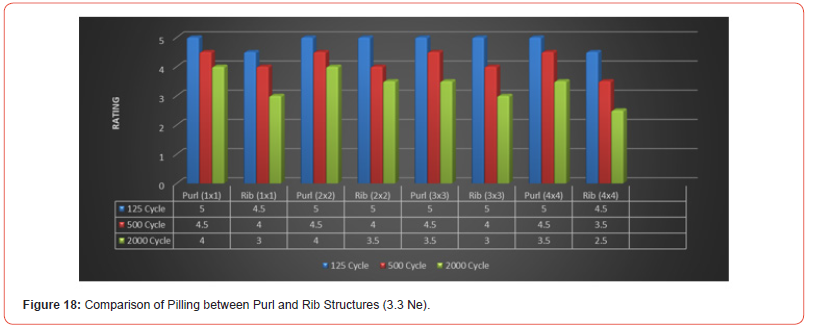
Comparison of pilling between purl and rib structures before wash: Based on the findings presented in Figures 18 and 19, it is clear that before washing, pilling was lower in 1x1 rib structures (for both yarn counts of 3.3 Ne and 4.1 Ne) compared to 1x1 purl structures. This trend was also observed in other structure types, such as 2x2 purl and rib, 3x3 purl and rib, and 4x4 purl and rib.
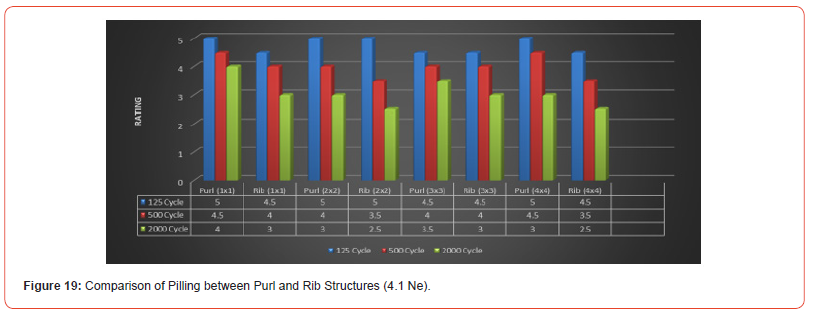
Comparison of pilling between purl and rib structures after wash:, According to the findings presented in Figures 20 and 21, it is clear that after washing, pilling in 1x1 rib structures (for both yarn counts of 3.3 Ne and 4.1 Ne) was either equal to or lower than pilling in 1x1 purl structures. This trend was also observed in other structure types, such as 2x2 purl and rib, 3x3 purl and rib, and 4x4 purl and rib.
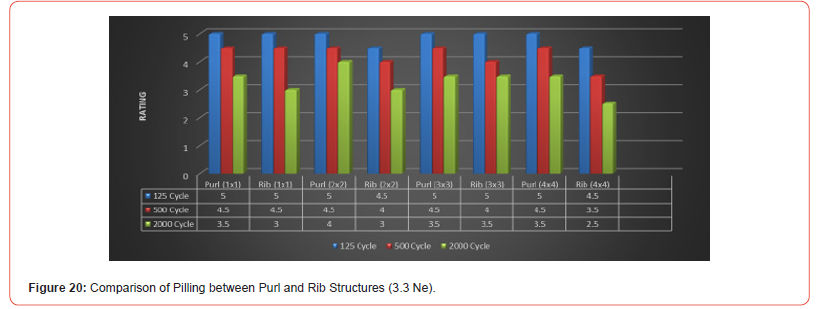
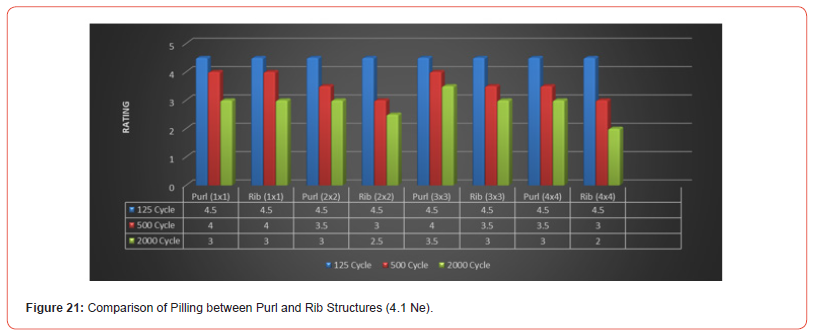
Comparison of pilling between purl structures: Based on Figures 22 and 23, it is apparent that the pilling of 1x1 purl structures (for both yarn counts of 3.3 Ne and 4.1 Ne) after washing was either equal or lower than the pilling of 1x1 purl structures before washing. This pattern was similarly observed for 2x2 purl, 3x3 purl, and 4x4 purl structures.

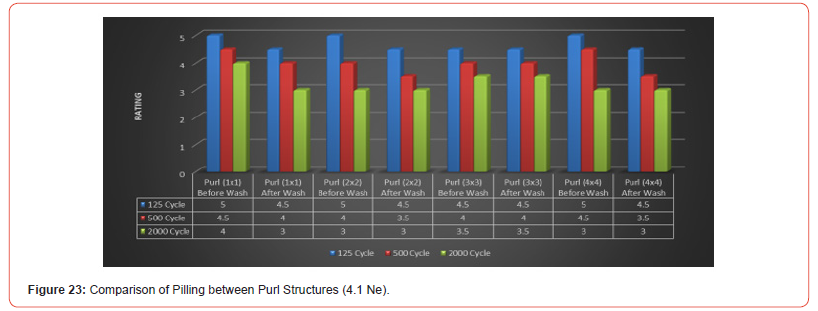
Discussion
Purl derivatives had lower WPcm and higher CPcm than rib derivatives, both before and after wash. After washing, purl structures showed higher WPcm and lower CPcm. GSM of purl derivatives were lower than rib derivatives, but purl structures showed higher GSM before wash. Shrinkage occurred in rib structures lengthwise and in purl structures widthwise, while relaxation occurred in the opposite direction for both. Purl derivatives had higher pilling resistance than rib derivatives before and after wash. Before wash, pilling resistance of purl derivatives was higher than after wash.
Limitation
As negative feed was used, variation in loop length was observed, despite the tension kept as low as possible.
Conclusion
This research is an approach to produce purl fabric by a hand driven V-Bed rib knitting machine and an attempt to find out some of the physical comparisons between purl derivatives and rib derivatives. It was evident that the fabric parameters like CPcm, WPcm, GSM, pilling, shrinkage and relaxation were different between purl and rib structures with different relaxation states such as dry relaxed and wet relaxed state. Eventually, it was an effort to promote the resurgence of purl structure which has almost been obsoleted.
Acknowledgement
None.
Conflicts of Interest
No conflict of interest.
References
- Srinivasulu K, Sikka M, Hayavadana J (2013) Study of Loop Formation Process on 1x1 V-Bed Knitting Machine: The Factor Affecting Loop Length and Validation of Model. International Journal of Advanced Research in Engineering and Technology (IJARET) 4(2): 259-260.
- Akaydin M, Can Y (2010) Pilling Performance and Abrasion Characteristics of Selected Basic Weft Knitted Fabrics. Fibres & Textiles in Eastern Europe 2010 2(79): 51-54.
- Parmar MS, Srivastava SK (1999) A Conventional Way to Incorporate Comfort in Knitted Fabric. Indian Journal of Fibre & Textile Research 24: 41-44.
- Singh G, Roy K, Vershney R, Goyal A (2011) Dimensional Parameters of Single Jersey Cotton Knitted Fabrics. Indian Journal of Fibre & Textile Research 36: 111-116.
-
Tahmina Akhter, Mst. Romana Akter, Jasnova Afroj Aurna, Mst. Jinia Rahman and Iftay Khairul Alam*. Comparison of Physical Properties of Purl- and Rib Structures Produced in a Hand-Driven V-Bed Rib Knitting Machine. Glob J Eng Sci. 11(2): 2023. GJES.MS.ID.000755.
-
Purl fabric, V-Bed rib machine, Manual loop transfer technique, Rib structures, Physical characteristics
-

This work is licensed under a Creative Commons Attribution-NonCommercial 4.0 International License.






